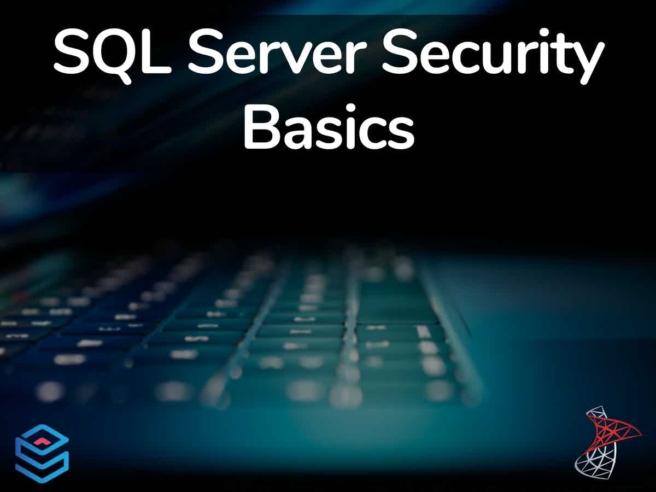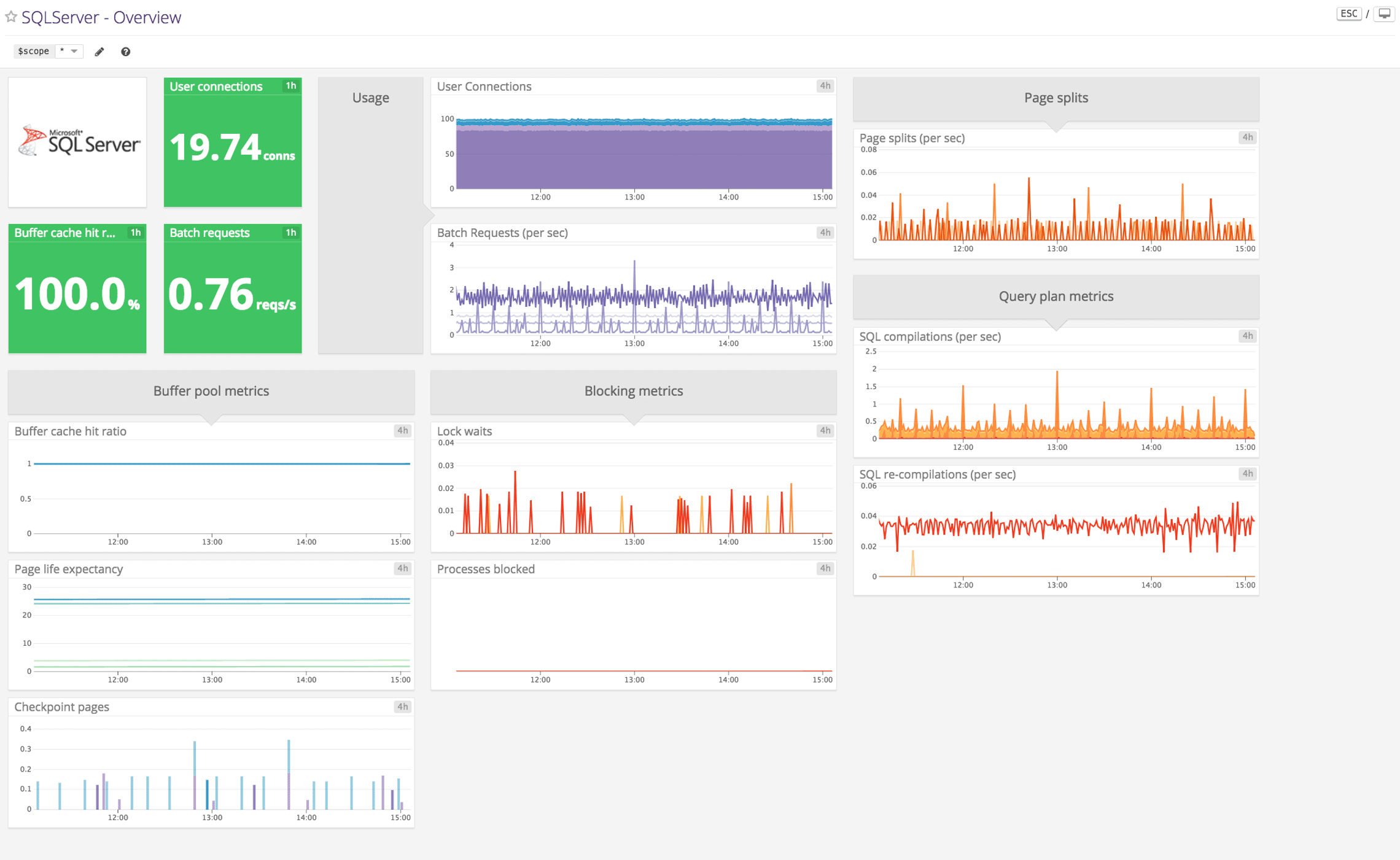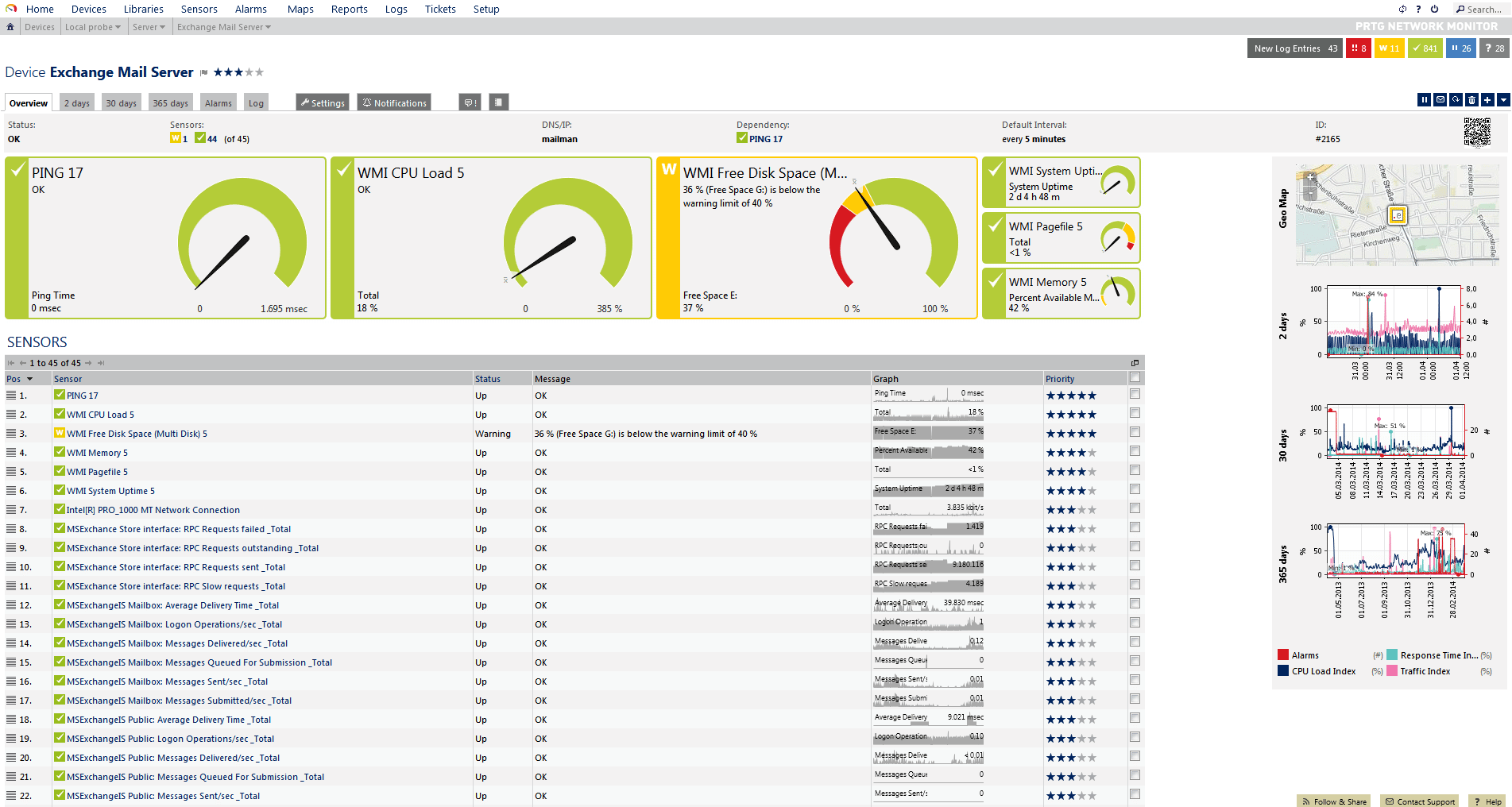Data breaches have cost companies billions of dollars, these issues are usually caused by improperly secured database servers. With Microsoft SQL Server being a popular solution, many of these breaches happen due to a lack of knowledge about SQL server security.
Using the right security measures can single-handedly elevate the cybersecurity of your entire infrastructure. Today, we’ll be looking at some SQL Server security basics as well as the best tools to let you enhance the security and performance of your IT infrastructure.
The top SQL Server security tools in our testing have been:
- SolarWinds Security Event Manager – FREE TRIAL An excellent database administration and monitoring software with a wide variety of use cases. It is extremely scalable, has a robust alerts system to let you know when anything goes wrong and offers SQL injection protection. The tool also integrates seamlessly with the rest of the SolarWinds suite.
- Datadog A versatile network monitoring solution with flexible pricing and autodiscovery capabilities.
- Microsoft Defender for SQL A dedicated SQL server monitoring tool that offers excellent Azure support.
- PRTG Network Monitor A sensor-based network monitoring solution that provides almost endless customizability.
Take Care Of Your Physical Security
Many new administrators underappreciate the impact physical security has on the security of your infrastructure. Many hacks happen with no technological involvement whatsoever, whether by social engineering or breaking into facilities. Physical security itself deals with how you protect the facility, detect intruders, and deal with your personnel’s privileges.
Physical security is usually implemented in a layered approach. Ideally, if an attacker gets through one or two layers of security, they should be faced with another one immediately afterward. A high degree of physical security will also do wonders to protect your servers from the elements.
So, what should you do to take your physical security to the next level? Microsoft suggests you follow these best practices:
- Ensure the server is placed in a facility only accessible by authorized individuals
- Place the devices hosting databases in a locked room with flood and fire suppression systems.
- Don’t directly connect the SQL server to the internet, instead, use the corporate intranet to install databases
- Ensure you’re regularly backing up your SQL servers & databases
- Store all of your backups off-site
Implementing these measures is relatively simple, but they can provide a massive increase in the security of your SQL servers.
Network Security Best Practices
Network security is a segment of cybersecurity dealing with protecting network infrastructures, specifically those of your database server from being accessed by unauthorized individuals. Network security combines multiple different layers to properly implement policies and controls on your network. These measures ensure only authorized users can access your database through the network.
Because of this, network security implementations always begin with ways to keep unauthorized personnel out of your network. This is the job of firewalls. Firewalls will prevent malicious traffic from getting to your server, but will also prevent data exfiltration if necessary.
Microsoft guidelines suggest that you should implement the following guidelines to get the most out of your firewalls:
- Place a firewall between your server and the internet and ensure that it’s enabled and turned on.
- Split your network up into security zones, each of which should be separated by firewalls selectively only admitting the transfers that are required.
- In a larger, multi-tier infrastructure, use multiple firewalls to set up screened subnets
- Ensure your interior firewalls allow Windows Authentication
- In case your application takes advantage of distributed transactions, you might want to set the firewall up to allow DTC instances.
- Disable any unnecessary ports or protocols on your servers. This reduces the attack surface of your infrastructure.
Implementing these best practices ensures you’re getting the most out of your firewalls and significantly decreases the attack surface of your infrastructure.
Ensuring Application & Data Security
Database administrators can do a lot to ensure application & data security within your infrastructure. The Microsoft SQL Server already has several in-built features that let you enhance your security, all that you need to do is use them.
Some of these measures you should take a look at are:
- Protecting against SQL and similar injection attacks SQL injections are a common form of attack where malicious code is injected into your SQL queries. From there, these scripts can damage and corrupt your database, or even steal your sensitive data. You can stop these attacks in their tracks by sanitizing database inputs. This in turn ensures that these inputs don’t have any characters that can be used to execute commands.
- Use stored procedures and parameterized commands, this also helps you avoid SQL injections. Make sure that you’re also protecting your SQL Server Login string. You can also use the SqlConnectionStringBuilder to create and validate connection strings, or simply use Windows authentication everywhere.
- Follow a policy of least privilege to ensure that only individuals that need to access a part of your database are privy to the information within.
- Ensure that your error logs are kept in a secure space, as verbose errors can reveal a lot about your system. You should make sure all of your procedural code has error handling capabilities.
- Privilege escalation attacks are another common way malicious actors can attempt to assume control of your network. To prevent these attacks, you should not only implement a policy of least privilege but also use certificates to sign procedures.
- DDoS or Distributed Denial of Service attacks is the most common form of cyberattacks where attackers will assault your database with millions of fake queries, leading to overload. In case you use an SQL server in the cloud, you can use DDoS protection services to minimize them.
Best Practices For SQL Server Security
- Conduct Regular Backups The most common SQL Server security mistake businesses make is neglecting the need for routine backups. Backing up your data not only ensures your data is available when you need it, but helps your database stay resilient in the face of a variety of different attacks. Using high-quality SQL Server backup software is a great investment for the health of your SQL server.
- Conduct Security Audits Regularly Security audits are not only required in most industries, but more than that, they help you find potential attacks before they happen and ensure the health of your database. Looking at missing objects, repeated login failures, and strange changes to your configurations are some of the steps you should be taking. Using SQL Server Audit is also a great way to do server and database-level audits.
- Establish A Strong Password Policy Using a password management solution or just a robust password strategy helps protect your SQL server against brute force attacks and data leaks.
- Update Regularly OS and SQL Server updates have crucial security updates that are good for the health and security of your overall infrastructure. Because of this, you should update as often as possible.
- Take Advantage of Encryption Using encryption protects you from a variety of attacks, including niche ones like MitM(man-in-the-middle) attacks. Using the in-built SSL/TLS and DPAPI encryption protocols protects the data within your databases.
- Use SQL Monitoring Software Humans can only do so much, and your team won’t have the time to have all bases covered constantly. Because of this, using a SQL monitoring tool to help you automate and improve your SQL server security efforts is a great idea.
The Best SQL Server Monitoring Tools
1. SolarWinds Security Event Manager – FREE TRIAL
The SolarWinds Security Event Manager is an excellent software for database admins of all kinds. With the SolarWinds SEM, you can monitor server logs, audit user logins, maintain security, schedule updates, and more.
Main Features:
- SQL injection protection
- Intuitive user interface
- Robust alerts system
- Great real-time monitoring features
- Helps you comply with security standards
The SEM tracks a variety of different metrics and immediately alerts you if it ever finds a suspicious interaction that could signal an attack. It also creates in-depth reports in a variety of formats.
The SolarWinds SEM gives you out-of-the-box event correlation rules which can help you troubleshoot issues and optimize SQL Server performance. The SEM also supports a variety of security assessment protocols and can assist you in protecting your SQL server from SQL injections. The tool is great at finding and disabling malicious actors and processes. It also has automated threat response features which you can set up as you see fit.
The SEM’s breadth of features might be a little too much for some smaller businesses. The SolarWinds SEM offers a 30-day free trial.
Download the 30-day FREE Trial
https://www.solarwinds.com/security-event-manager
2. Datadog
Datadog is an agent-based software capable of monitoring both cloud and on-premises infrastructures. The tool has an autodiscovery feature that lets it automatically discover all of the apps, devices, and servers in your infrastructure. Once that’s done, you can monitor all network activity from the Datadog dashboard.
Main Features:
- A variety of flexible features
- Extremely scalable
- Provides 2 default dashboards to monitor SQL Server performance
- Monitors both on-prem and cloud infrastructures
- Customizable pricing
Datadog gives you an easy way to constantly keep tabs on the health and performance of your SQL server. It gives you tools and tracked metrics for SQL Server monitoring. In addition to this, its dashboard is extremely customizable, but by default, it provides you with two:
- The Screenboard: Here you can have a real-time look at all of your SQL Server instances
- The Time board: A place where you can look at moments individually to correlate your system events and metrics with your SQL server metrics.
Datadog’s free trial is a bit on the short side, sitting at 14 days.
3. Microsoft Defender for SQL
Microsoft Defender for SQL is a dedicated SQL Server security software helping you find and resolve SQL Server issues. The tool will automatically scan your systems for any sign of vulnerability and notify you about potential fixes.
Main Features:
- Excellent Azure support
- Extremely easy to use
- Lightweight
- Can support hybrid infrastructures
The tool comes in two different Microsoft Defender plans:
- Azure SQL Database Servers: This plan protects your Azure SQL databases and managed instances, as well as the dedicated SQL pool within Azure synapse.
- SQL Servers on machines: This plan protects not only your Azure-native servers but also hybrid environments including on-prem machines and other cloud infrastructures.
Both plans are available at a subscription and resource level. Once you enable them, all of their supported resources are immediately protected.
While the tool doesn’t provide much in the way of customization, it’s one of the simplest and easiest to use out-of-the-box tools out there. It’ll detect threats and help you troubleshoot all the while giving you one of the smoothest SQL Server security experiences out there.
If you’re looking for more versatile functionalities, the Microsoft Defender for SQL might not be the tool for you. The tool offers a 30-day free trial.
4. Paessler PRTG Network Monitor
The Paessler PRTG Network Monitor is an agentless network monitoring software. It is a sensor-based software providing a wide variety of different features and sensors to give you the most customizable experience possible.
Main Features:
- Extremely customizable
- Sensor-based pricing
- Monitors your entire network
- You can easily scale up or down
PRTG lets you measure the entire time taken for the execution of an SQL query. It will also monitor everything from CPU load to network traffic and metrics. The tool comes with out-of-the-box configurations for all major databases. For example, the Microsoft SQL v2 Sensor is used to monitor request and query response times. The tool is also quite versatile, as it has the appropriate sensors for pretty much all of your network monitoring needs.
The tool also has an extremely flexible, per-sensor pricing plan. This lets you customize your installation of PRTG exactly how you want it.
The complexity of the PRTG Network Monitor can be a bit overwhelming at times. The tool is free for up to 100 sensors, and lets you experience an unlimited number of sensors at a 30-day free trial.





